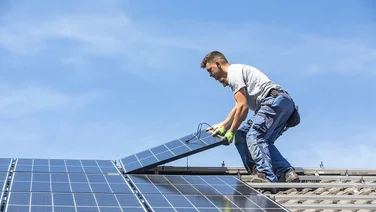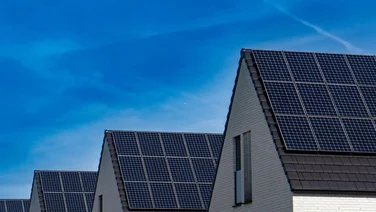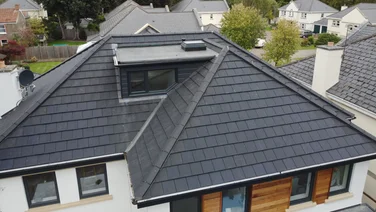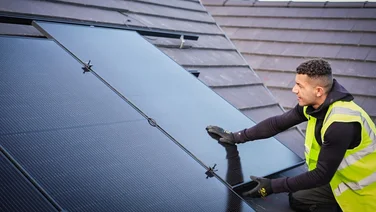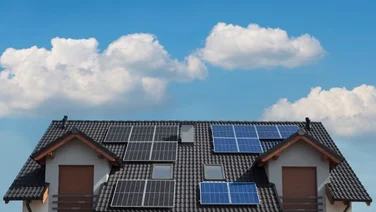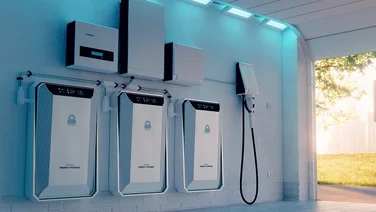- What are printed solar panels?
- How are printed solar panels made?
- How do printed solar panels compare to standard panels?
- What are the pros and cons of printed solar panels?
- Can you buy printed solar panels in the UK?
- How much will printed solar panels cost?
- How much will printed solar panels save you?
- Next steps
✔ Printed solar panels use a special ink to turn daylight into electricity
✔ They can be printed on paper, plastic, textiles, and steel
✔ You’ll soon be able to attach solar cells to clothes and laptops
Solar panels of all types are becoming more affordable, and it’ll only continue to fall as researchers develop different forms of the technology – like printed solar panels.
In this guide, we’ll explain what printed solar panels are, how effective they currently are, and when we expect them to take the solar industry by storm.
If you want to get your own solar installation, you can compare solar panel prices with our help. Just provide a few quick details, and our expert installers will be in touch with free quotes.
Where do you want to install solar panels?
Get started
A scientist holds up a printed solar cell (MIT)
What are printed solar panels?
Printed solar panels are thin, lightweight devices that use solar ink to capture daylight and turn it into electricity.
Conventional commercial printers can press this ink, which contains all the semiconductor material and electrodes needed to generate solar energy, onto a large and disparate number of surfaces.
Companies are currently limited by the heavy, inflexible nature of silicon, which is widely used in solar panels – but soon, that may not be the case.
Manufacturers could theoretically create small, flexible solar cells and attach them to everything from windows and tents to mobile phones and clothes.
How are printed solar panels made?
Printed solar panels are made by printing solar ink onto plastic surfaces – like a more large-scale version of you printing a document at home.
This process can be carried out by standard industrial printers, so solar manufacturers won’t have to buy new, expensive technology if they want to move into this space.
The use of plastic instead of silicon makes these printed solar cells even easier to recycle than standard solar panels – and there’s also the potential to use materials beyond plastic.
Scientists at MIT have proven that you can print solar ink onto other surfaces, including newsprint, plastic food wrap, printer paper, textiles, and tissue paper, while other researchers have managed to print solar ink onto steel.
How do printed solar panels compare to standard panels?
Printed solar panels currently have roughly half the standard solar panel efficiency.
Scientists at Swansea University have created large-scale devices with an impressive 10.8% efficiency rating, made by printing solar ink on perovskite.
And manufacturers in Australia have hit 19% efficiency for small-scale printed perovskite solar cells, which shows an encouraging rate of progress.
However, when it comes to matching the 20-24% efficiency that the best solar panels achieve on a household-powering scale, printed solar panels have some way to go.
And the 33.7% efficiency rating which a team of scientists in Saudi Arabia achieved in 2023 with a single perovskite-silicon cell is a distant dream.
What are the pros and cons of printed solar panels?
- Lightweight
- Cheap to produce
- Flexible
- Huge variety of potential uses
- More recyclable than regular panels
- Typical lifespan of six months
- Average efficiency of 10%
- Not commercially available
The advantages of printed solar panels
Printed solar panels are flexible, lightweight, and more recyclable than standard silicon panels, since they’re made almost entirely of plastic.
They can also – in theory – be manufactured quickly and cheaply, while their adaptable form means you should be able to put a printed solar panel on just about any surface.
“Imagine a world where everyone has access to electricity, and where every surface can generate clean, low cost, sustainable energy from the sun. That’s a world I want to live in.”
– Professor Dastoor, of Newcastle University in Australia
Every electronic item in your home could be mostly or even completely powered by the sun, just by sticking on a paper-thin sheet of plastic.
When they enter mass production, companies can simply make them with the commercial printers they already own, and installation should be a breeze.
Instead of paying solar panel installation costs for labour, materials, and scaffolding, you’ll be able to follow simple instructions to attach a printed solar panel to any number of objects.
The disadvantages of printed solar panels
Printed solar panels are still in development, meaning there are several flaws to be remedied before they can be sold commercially for use in homes all over the world.
Currently, printed solar cells have a lifespan of just six months, which is nothing compared to the minimum of 25 years you’ll typically get from silicon solar panels.
They can also only reach 10.8% efficiency when printed as a panel instead of individual cells, so they’re not going to provide electricity for your whole home – but they’re more than capable of powering individual devices.
Can you buy printed solar panels in the UK?
You can’t buy printed solar panels in the UK at the moment.
They currently only exist in research and development departments and university laboratories.
However, it’s just a matter of time before these technological marvels enter the market, so we’ll keep our eyes peeled and update this article when they’re available.
When will printed solar panels be available to buy?
Printed solar panels should be available to buy in the next few years, and certainly by 2030.
The University of Newcastle in Australia demonstrated the technology at a public light display in 2020, so researchers are definitely on the right path.
As soon as a company picks up the technology and runs with it, the market will see an explosion in popularity.
How much will printed solar panels cost?
Printed solar panels cost around £5 per square metre to manufacture.
This is an incredible reduction in costs compared to traditional silicon solar panels, which typically cost £30 per square metre to make.
And of course, that’s just the panels. When you buy a system, you need other equipment – like an inverter and brackets – as well as labour and business costs like scaffolding and transportation.
This all adds up to £393 per square metre of solar panel, on average.
Printed solar panels shouldn’t come with any of these costs, and they’re currently six times cheaper to make than silicon panels – meaning they should be a lot cheaper.
How much will printed solar panels save you?
Printed solar panels could save the average three-bedroom household £72 per year – about 10% on its annual electricity bills – if they were sold with an efficiency rating of 10%.
This assumes you’d be able to place printed solar panels on 10 electrical objects that regularly receive daylight.
As more time and funding goes into their development, they should be able to save you even more money, since they’ll inevitably become more efficient and long-lasting.
Next steps
Printed solar panels are one of the most exciting developments underway in the solar industry – but they’re not currently available, and won’t be for a while.
If you’re considering buying solar panels now, the best first step is to get multiple quotes, so you can get the best deal possible for your home.
Kick-start this process with our free comparison tool. Just fill in a few details and our trusted suppliers will get in touch with free quotes.


